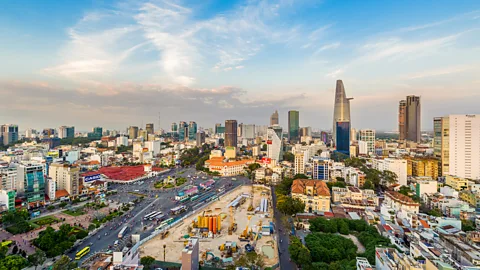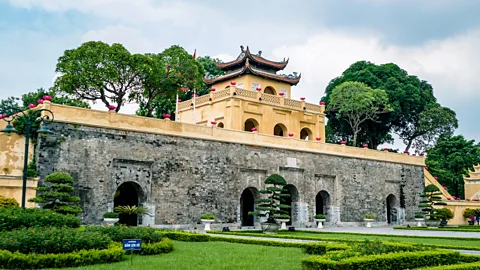A return to Vietnam, 50 years after the war
 Getty Images
Getty ImagesHalf a century after the end of a devastating conflict that left much of the nation in ruins, Vietnam has emerged as one of Asia's most popular destinations.
April 2025 marks the 50th anniversary of when the government of Saigon surrendered to North Vietnamese forces, ending the decades-long Vietnam War. In many ways, the nation is still grappling with this dark time and the lingering effects on both its landscape and people. However, new generations of Vietnamese citizens are now working to shed the nation's war-torn past and instead reveal the country's beauty and unique cultural heritage to the world.
Since 1997, when the country first opened to tourists, Vietnam has become one of South East Asia's most popular destinations. Renowned for its delicious street food markets, vibrant cities, unique mix of French colonial architecture and stunning natural landscapes from lush jungles to jagged peaks, the nation is currently experiencing a surge of foreign visitors and is on pace for a record-breaking year.
In the most recent episode of BBC's The Travel Show, Vietnamese American host William Lee Adams travels across the country on an emotional journey to reconnect with his mother's country of origin and to lay his brother's ashes in the bustling metropolis of Ho Chi Minh City (formerly Saigon) where his family has a crypt.
In many ways, Saigon was the epicentre of the Vietnam War in 1960s and '70s, as it served as the headquarters for US military operations in the region. However, the city's history stretches back at least 300 years before this conflict, and its past is reflected in the ornate temples and pagodas, vibrant night markets and mix of Asian and European influences found in this nine-million person metropolis.
As in much of Vietnam, food is a major draw for travellers to Ho Chi Minh City. Street food dishes like bot chien (pan-fried rice flour cakes served with papaya, shallots and green onions) found at places like the historic Bến Thành Market are popular, as are more upscale restaurants such as the Michelin-starred Akuna. "The market, and food in general is kind of like the heart of Vietnamese culture," tour guide and content creator Lylla told the Travel Show. "Food is that important."
More like this:
• Saving Vietnam's endangered langur monkeys
Beyond the markets, Ho Chi Minh City is a blend of Vietnamese, French and international influences. The ornate French-built Saigon Opera House, which opened in 1898, stands as a reminder of the city's colonial past, while the more contemporary Lotus Gallery (one of the city's first private art galleries) showcases the work of modern Vietnamese and other South East Asian artists.
One thing you won't find too much mention of in Ho Chi Minh City is the armed conflict. In fact, many locals are reluctant to talk about what is known locally here as the "American War".
"The official viewpoint is, 'we won the war, so there is no trauma'," said Nguyễn Phan Quế Mai, a Vietnamese author. "That's why I felt the need to document the hidden trauma… which has been brushed aside, unacknowledged."
 Getty Images
Getty ImagesEven so, there are several places where visitors can go to learn about the impact the war had on the city and surrounding countryside. The War Remnants Museum preserves important artefacts and educates visitors about the consequences of war, while the Chu Chi tunnels showcase the hardships that Vietnamese soldiers endured during the conflict.
Ho Chi Minh City is connected to the northern part of the country by the North-South Railway, often called the "Reunification Express". First built in 1899, the train, which travels more than 1,700km from Ho Chi Minh City to Hanoi on a single track, was bombed several times during the Vietnam War to cut off the important connections between the communist north and US-controlled south of the country. Today, the ride is a great way to get a view of some of the country's most beautiful landscapes, as it passes by the breathtakingly blue waters of Nha Trang's beaches, and through the jungles of the Annamite Mountain range. The train also makes stops at several popular tourist towns, such as Da Nang and Hoi An, before reaching its final destination, the historic capital city of Hanoi.
Once the capital city of the communist north, Hanoi was founded in 1009 AD as the imperial city for the Ly Dynasty. Beginning in 1873, the city served as the capital of the French-controlled colony and remains Vietnam's capital today. The city's diverse background is reflected in its architecture, particularly the city's Old Quarter, with its mix of Vietnamese and French colonial architecture.
For a deep dive into Hanoi's international past, visit the Imperial Citadel of Thang Long, a Unesco World Heritage site that dates back to the 7th Century. The site offers guided tours spanning nearly 1,300 years of Vietnam's past.
In addition to being the legislative capital of Vietnam, Hanoi is also considered the nation's cultural capital and it's home to a thriving arts and education scene. For example, what is now known as the Temple of Literature once served as Vietnam's first university, and students still go to the site to pray for good grades. The city also boasts contemporary art galleries and museums, such as the Vietnam National Fine Arts Museum and the Hanoi Studio Gallery.
 Getty Images
Getty ImagesNo visit to Hanoi is complete without stopping by Dong Xuan Market, one of the largest and oldest in the country. It's a two-storey community hotspot where locals and travellers from around the globe come to buy local stir-fried dishes, souvenirs, spices and even pets.
"Every time I've been to Vietnam there's been this sense of 'something is now complete'," Adams said at the end of his journey. "But I actually view this trip as a new chapter opening."
--
If you liked this story, sign up for The Essential List newsletter – a handpicked selection of features, videos and can't-miss news, delivered to your inbox twice a week.
